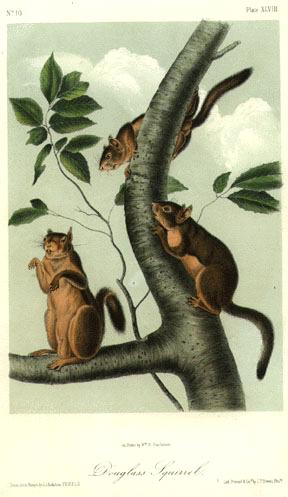

48 Douglass' Squirrel
SCIURUS DOUGLASSII.--BACH.
[Tamiasciurus douglasii]
DOUGLASS' SQUIRREL.
[Douglas' Squirrel]
PLATE XLVIII.--Male and Female.
S. Hudsonio quarta parte major; cauda corpore curtiore; supra subniger,
infra flavus.
CHARACTERS.
About one-fourth larger than the chickaree (S. Hudsonius); tail, shorter
than the body; colour, dark-brown above, and bright-buff beneath.
SYNONYMES.
SCIURUS DOUGLASSII, Gray, Proceedings Zool. Society, London, 1836, p. 88,
named, but apparently not described.
SCIURUS DOUGLASSII, Bachman, monograph of the Genus Sciurus, Proceedings
Zool. Soc., London, 1838.
DESCRIPTION.
Incisors, a little smaller than those of Sciurus Hudsonius; in the upper
jaw the anterior molar, which is the smallest, has a single rounded eminence on
the inner side; on the outer edge of the tooth there are two acute points, and
there is one in front; the next two grinders, which are of equal size, have each
a similar eminence on the inner side, with a pair of points externally; the
posterior grinder, although larger, is not unlike the anterior one. In the
lower jaw the bounding ridge of enamel in each tooth forms an anterior and
posterior pair of points. The molars increase gradually in size from the first,
which is the smallest, to the posterior one, which is the largest.
This species, in the form of its body, is not very unlike Sciurus
Hudsonius; its ears and tail, however, are much shorter in proportion, and in
other respects, as well as in size, it differs widely from Hudsonius.
Head, considerably broader; and nose, less elongated and blunter than in
the latter; body, long and slender; ears, rather small, nearly rounded, slightly
tufted posteriorly. As usual in this genus, the third inner toe in the longest,
and not the second, as in the spermophiles.
COLOUR.
The whiskers, which are longer than the head, are black; hair from the
roots to near the points, plumbeous, tipped with brownish-gray, a few
lighter-coloured hairs interspersed, giving it a dark-brown appearance. When
closely examined it has the appearance of being thickly sprinkled with minute
points of rust-colour on a black ground. The tail, which is distichous but not
broad, is for three-fourths of its length the colour of the back; in the middle
the fur is plumbeous at the roots, then irregularly marked with brown and black,
and is tipped with dull white, giving it a hoary appearance; on the extremity of
the tail the hairs are black from the roots and are tipped with light brown; the
belly, the inner sides of the extremities and the outer surfaces of the feet,
together with the throat and mouth and a line above and under the eyes, are
bright-buff. The colours on the upper and under parts are separated by a line
of black, commencing at the shoulders, and running along the flanks to the
thighs ; this line is broadest in the middle of the body and is there about
three lines wide, narrowing from thence to a point. The hairs, which project
beyond the outer margins of the ears and form a slight tuft, are dark-brown, and
in some specimens black.
DIMENSIONS.
Inches. Lines.
Length from point of nose to insertion of tail . . . . . 8 4
Tail (vertebrae) . . . . . . . . . . . . . . . 4 6
Tail, including fur . . . . . . . . . . . . . . 6 4
Height of ear posteriorly . . . . . . . . . . . . 0 6
Palm to end of middle fore-claw . . . . . . . . . . 1 4
Heel and middle hind-claw . . . . . . . . . . . . 1 10
HABITS.
Our specimens of Douglass' Squirrel were procured by Mr. TOWNSEND. He
remarks in his notes:--"This is a very plentiful species, inhabits the pine
trees along the shores of the Columbia River, and like our common Carolina
squirrel lays in a great quantity of food for consumption during the winter
months. This food consists of the cones of the pine, with a few acorns. Late
in autumn it may be seen very busy in the tops of the trees, throwing down its
winter stock; after which, assisted by its mate, it gathers in and stows away
its store, in readiness for its long incarceration."
GEOGRAPHICAL DISTRIBUTION.
DOUGLASS obtained his specimens of this Squirrel on the Rocky Mountains,
and TOWNSEND found it on the Columbia River.
GENERAL REMARKS.
This species was found by DOUGLASS and by TOWNSEND about the same time.
These gentlemen, if we have been rightly informed, met together in the far West.
We drew up a description from specimens sent us by Mr. TOWNSEND, and used the
grateful privilege of s describer, in naming it (S. Townsendii) after the
individual who we supposed had been the first discoverer. Under this name we
sent our description to the Acad. of Nat. Sciences of Philadelphia, which was
read Aug, 7th, 1838. After arriving in England, however, the same year, we saw a
similar specimen in the Museum of the Zool. Society, and heard that it had been
named by GRAY, on the 11th October, 1836, who had called it after DOUGLASS, (S.
Douglassii.) He had not, as far as we have been able to ascertain, published
any description of it. All that we can find in reference to this species is the
following: "Mr. GRAY gave a description of two foxes, a squirrel (Sciurus
Douglassii), and three hares." The foxes and hares were described by him in the
Magazine of Nat. Hist., (new series,) Nov., 1837, vol. i., p. 578, but for some
reason he appears never to have published a description of this species.
We, however, supposing that he had described it, immediately changed our
name to that proposed by GRAY, and in our monograph of the genus assigned to him
the credit of having been the first describer, although he had, it appears, only
named the animal.
|